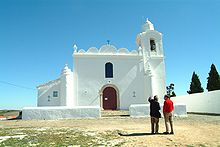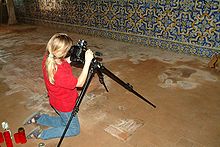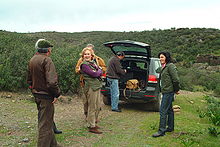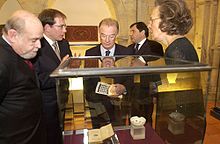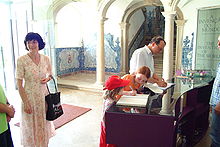- Department of Historical and Artistic Heritage of the Diocese of Beja
-
The Historical and Artistic Heritage Department of the Diocese of Beja, in Portuguese Departamento do Património Histórico e Artístico da Diocese de Beja (DPHA), gathers a group of volunteers with different backgrounds on various areas of the cultural heritage. It is responsible for the safeguard and care of the historical churches of the southern Alentejo, in Southern Portugal, operating in a 12 300 km2 area – the less populated of this country, but rich in religious monuments from the paleochristian period to the present. DPHA began its work in 1984, facing a complex situation: thefts of works of sacred art and illegal transactions with antiquarians were taking place; over a hundred churches, especially rural shrines, had been abandoned; in wealthier villages, unqualified local restorers had been depreciating retables, sculptures, canvas and mural paintings, organs, etc., with acrylic glues and paints, striking colours, plastic additions.
Under the direction of Professor José António Falcão, DPHA launched a modern inventory of the cultural heritage of this area, which includes a computerised database. It also created a counselling service covering from preventive conservation to technical and law matters, as a support to parishes. Co-operating with local authorities, it has been providing training courses to priests and volunteers; protection committees were created in the main monuments, some of which had been kept closed for long, and above all a network of museums has been created.
Sacred art exhibitions have proven to be public successes, such as “Between Heaven and Earth”, “The Shapes of the Spirit” or “The Invention of the World”. More than 50 historic churches and 1000 works of art were restored or preserved according to high scientific standards.
25 years later, the population of Southern Portugal and visitors to the region benefit from a much more favourable environment for the safeguard and display of their religious heritage. DPHA is now known, respected, and followed as a role authority in national territory and it co-operates with similar institutions in countries abroad, such as Spain, Italy, Belgium, France, Germany, Poland, and Brazil.[1]
Contents
Literature
- As Vozes do Silêncio. Imaginária Barroca da Diocese de Beja, Beja – Lisboa, Departamento do Património Histórico e Artístico – Estar Editora, 1997.
- Rosa Mystica – Mariendarstellungen aus dem Südlichen Portugal, Regensburg, Schnell und Steiner, 1999.
- Entre o Céu e a Terra. Arte Sacra da Diocese de Beja, I-III, Beja, Departamento do Património Histórico e Artístico da Diocese de Beja, 1998.
- O Alto-Relevo de Santiago combatendo os Mouros da Igreja Matriz de Santiago do Cacém, Beja – Santiago do Cacém, Departamento do Património Histórico e Artístico da Diocese de Beja – Câmara Municipal de Santiago do Cacém, 2001 (colab.)
- As Formas do Espírito. Arte Sacra da Diocese de Beja, I-III, Beja, Departamento do Património Histórico e Artístico da Diocese de Beja, 2004.
- Fragmentos de Eternidade. Imagens da Virgem na Arte dos Séculos XVI-XIX, Alpiarça, Casa dos Patudos – Museu de Alpiarça, 2004.
- O Jardim das Hespérides. Pintura Espanhola do Século XIX na Colecção da Casa dos Patudos, Alpiarça, Casa dos Patudos – Museu de Alpiarça, 2005.
- Visões do Invisível – Património Religioso da Margem Esquerda do Guadiana, Beja, Departamento do Património Histórico e Artístico da Diocese de Beja, 2005.
- A a Z – Arte Sacra da Diocese de Beja, Beja, Departamento do Património Histórico e Artístico da Diocese de Beja, 2006.
- Filhos do Sol, Filhos da Lua. Aspectos da Criação de Gado Bovino e da Tauromaquia na Casa dos Patudos, Alpiarça, Casa dos Patudos – Museu de Alpiarça, 2006.
- Os Corpos e as Almas. Obras de José Malhoa na Colecção da Casa dos Patudos, Alpiarça, Casa dos Patudos – Museu de Alpiarça, 2006.
- XIX Século XX. Momentos da Pintura Portuguesa na Casa dos Patudos, Alpiarça, Casa dos Patudos – Museu de Alpiarça, 2007.
- Un Río de Agua Pura. Arte Sacro del Sur de Portugal, Borja – Beja, Centro de Estudios Borjanos, Institución “Fernando El Católico” – Departamento do Património Histórico e Artístico da Diocese de Beja, 2008.
- O Coração da Terra. Aspectos da Ruralidade na Arte Europeia (Séculos XVII-XX), Beja, Departamento do Património Histórico e Artístico da Diocese de Beja, 2008.
- Atmosferas, Pessoas, Narrativas. Um Relance sobre a Arte do Ocidente (Séculos XVII-XX), Beja, Departamento do Património Histórico e Artístico da Diocese de Beja, 2009.
- Imagens Eloquentes. Arte Europeia dos Séculos XVIII-XX, Beja, Departamento do Património Histórico e Artístico da Diocese de Beja, 2010.
Contacts
Largo dos Prazeres, n.º 4 | 7800-420 Beja (Portugal) | Tel. 284 320918 | Fax: 284 320052 | e-mail: dphadb@sapo.pt
References
- ^ José António Falcão, “Vinho Velho em Odres Novos”, em Silêncio, Lisboa, MU Records [booklet do CD], 2009, pp. [9-11].
External links
Categories:- Organisations based in Portugal
- Portuguese culture
Wikimedia Foundation. 2010.


